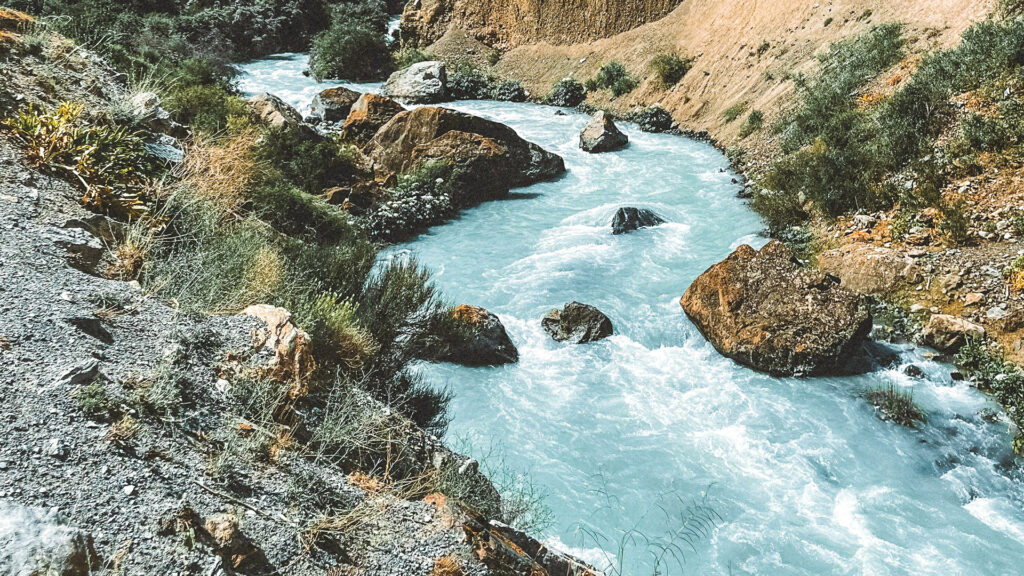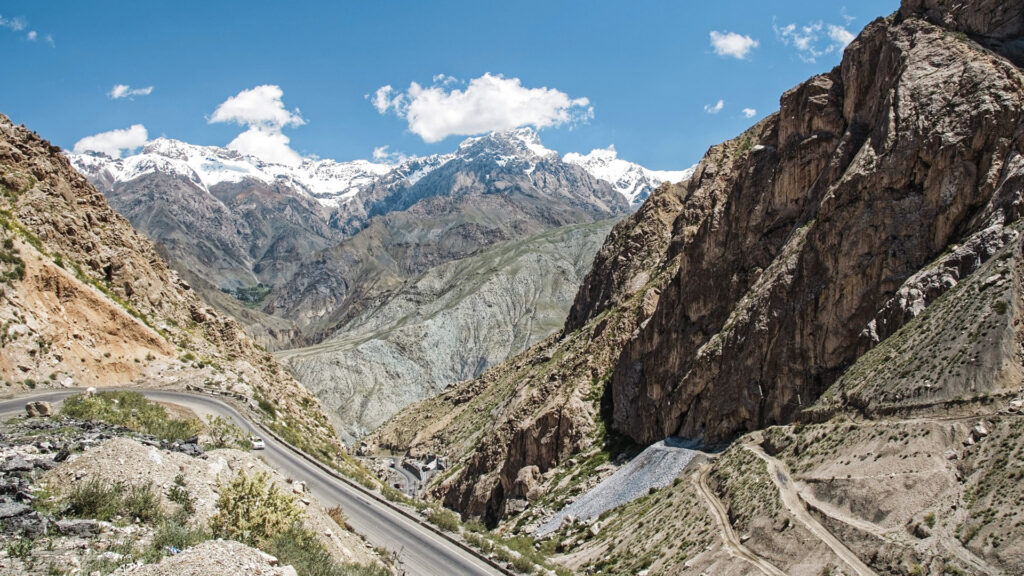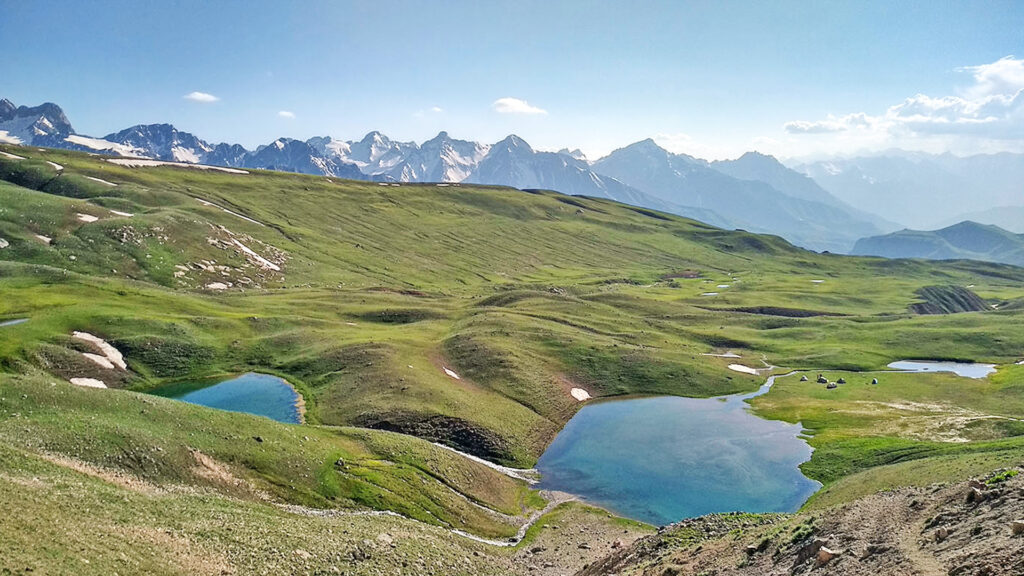Tap to explore



Venture deep into Tajikistan’s remote Yaghnob Valley on a 9-day trek through one of the world’s most isolated regions. Cross high mountain passes, sleep under star-filled skies, swim in glacier-fed lakes, and meet the Yaghnobi people, guardians of a thousand-year-old culture. An unforgettable journey of raw wilderness, ancient traditions, and alpine beauty.

Hiking
Swimming
Challenging
0–2: Scenic
Relaxed pace on smooth, predictable trails. Open to all abilities, with plenty of rest and minimal effort required.
3–4: Active
Varied terrain with steady climbs and uneven paths. Ideal for those comfortable with full days outdoors at a steady pace.
5–6: Adventurous
Extended routes with steeper or exposed sections. Involves occasional challenges requiring stamina and confidence on mixed ground.
7–8: Challenging
Sustained effort across remote, advanced terrain with significant elevation gain. Requires strong endurance and mental focus.
9–10: Hardcore
Long, committing days in wild, isolated environments. Demands excellent conditioning, thorough preparation, and consistent resilience.
(We’re refining future routes,
sign up to our newsletter to keep updated! )
Past trips:
Aug & Sept 2024
Highlights
Travel deep into the Yaghnob Valley, one of the most isolated regions on earth, completely cut off for six months of the year.
Meet the Yaghnobi people, direct descendants of the ancient Sogdians, preserving a language and culture dating back over 1,000 years.
Cross the dramatic Anzob Pass at 3,372 metres with jaw-dropping panoramic views over Tajikistan’s remote mountain wilderness.
Trek wild, remote trails through abandoned villages, lush alpine valleys, and untouched highlands rarely visited by outsiders.
Climb to the spectacular Leila Pass at 3,900 metres, the highest point of the trek, surrounded by glaciers and vast mountain ranges.
Camp beneath star-filled skies, completely off-grid, immersed in total silence and nature’s raw beauty.
Swim in the crystal-clear, turquoise, waters of the Leilakul Lakes, reflecting the towering peaks in absolute stillness.
Stay with Yaghnobi families in their remote mountain homestays, sharing traditional food and stories of life in isolation.
Descend through the breathtaking Ziddi Valley, past ancient shrines, gorges, and rivers cutting through the rugged landscape.
Explore Dushanbe’s vibrant markets, & cafes and take a well-deserved (optional) spa visit after the trek.
Itinerary
ARRIVAL IN DUSHANBE
(Arrival flexible schedule)
Route: Dushanbe Airport – City Centre (15 km / 9.3 mi) | Altitude: 800m
Arrive in Tajikistan’s capital and transfer to your hotel. After check-in, spend a relaxed afternoon exploring Dushanbe’s highlights, including Rudaki Park and the National Museum. Overnight at a central Dushanbe hotel.
DUSHANBE TO MARGIB (YAGHNOB VALLEY)
08:30 – 13:00 | 4 hrs 30 mins
Route: Dushanbe – Anzob Pass – Margib (120 km / 74.6 mi, +2600m / -1100m) | Altitude: 2,300m
Optional acclimatisation walk: 1–2 hours. Leave Dushanbe behind as you head into the mountains, crossing the dramatic Anzob Pass before descending into the green, remote Yaghnob Valley. On arrival in Margib, home to the ancient Yaghnobi people, enjoy a traditional dinner. Overnight at a family run guesthouse in Margib.
MARGIB TO BIDEV
08:30 – 15:30 | 7 hrs
Route: Margib – Bidev (23 km / 14.3 mi, +250m / -0m) | Altitude: 2,550m
Follow the Yaghnob River upstream, passing through small Yaghnobi villages and summer pastures as the trail gently ascends to the village of Bidev.
Overnight at a local homestay in Bidev.
BIDEV TO KIRYONTE
08:30 – 14:30 | 6 hrs
Route: Bidev – Kiryonte (18 km / 11.2 mi, +150m / -150m) | Altitude: approx. 2,600m
Trek deeper into the Yaghnobi heartland, moving through abandoned settlements and remote valleys before reaching the green meadows around Kiryonte.
Overnight wild camping or local homestay.
KIRYONTE TO DAHANA
08:30 – 14:30 | 6 hrs
Route: Kiryonte – Dahana (22 km / 13.7 mi, +200m / -0m) | Altitude: 2,800m
Retrace the path back towards Tagobikul Valley, crossing wild, rugged terrain. Camp is set near the now-abandoned village of Dahana.
Overnight at our wilderness camp near Dahana.
DAHANA TO UPPER TAGOBIKUL
08:30 – 13:30 | 5 hrs
Route: Dahana – Upper Tagobikul (10 km / 6.2 mi, +400m / -0m) | Altitude: 3,200m
Leave the last signs of settlement behind and ascend into the wild Tagobikul Valley. The trail steepens as you head deeper into this untouched landscape.
Overnight in tents along the Tagobikul River.
LEILA PASS TO LEILAKUL LAKES
08:30 – 16:30 | 8 hrs
Route: Upper Tagobikul – Leila Pass – Leilakul Lakes (14 km / 8.7 mi, +700m / -500m) | Altitude: max 3,900m / camp at 3,400m
The most challenging day of the trek begins with a steep climb to Leila Pass, the highest point of your journey, offering wide open views of the Tagobikul and distant peaks. Descend to the Leilakul Lakes, swim in the turquoise waters. Overnight in tents beside Leilakul Lakes.
LEILAKUL TO ZIDDI AND RETURN TO DUSHANBE
08:30 – 16:00 | 7 hrs 30 mins
Route: Leilakul – Ziddi – Dushanbe (10 km / 6.2 mi trek, 90 km / 55.9 mi drive, -2200m) | Altitude: 3,400m → 1,200m → 800m
Descend through the picturesque Ziddi Valley, passing panoramic viewpoints and the Khoja Sanghok natural spring. After meeting your driver, return to Dushanbe for a well-earned (optional) visit to Spa Hayot. Overnight in a well-located hotel in Dushanbe.
DEPARTURE
(1 hour)
Route: Dushanbe – Airport (15 km / 9.3 mi, +0m / -0m) | Altitude: 800m
Breakfast at your hotel then transfer to Dushanbe International Airport for your flight home.
Essentials

We will meet at Dushanbe airport

All accommodation is based on twin sharing. Single rooms maybe available in Dushanbe or during the camping, please contact us to discuss any specfic requirements.
This trip combines simple hotels, village homestays, and wild camping to reflect the remote, off-grid nature of the region:
2 nights in a hotel in Dushanbe (Day 1 and Day 8)
3 nights in traditional Yaghnobi homestays (Days 2, 3, and 4)
4 nights wild camping in remote alpine locations (Days 5, 6, 7, and potentially Day 4 depending on final route)
Homestays are basic but welcoming, with shared facilities and hearty local meals. During the camping section, we provide all group gear (tents, cooking equipment, etc.), but there are no showers and only basic toilet arrangements. This is a rustic, immersive experience.
Guests can extend their stay at the same hotel in Dushanbe for $70/night (twin share)

What’s included

All accommodation.

All meals up until and including breakfast on Day 9.

All transport.

All group camping equipment plus, sleeping bags and trekking poles.

This trek is in an extremely remote region requiring a full logistics team: horsemen, donkeys, a cook, and mountain support staff.

Guiding : we will have a local Mountain Guide and a female Cultural Liaison & Interpreter accompanying us and our She Peaks host.
What’s not included

International flights.

Travel insurance (required, see section on insurance).

We will provide
– A warm sleeping bag (suitable for alpine nights)
– Insulated sleeping mat
– Telescopic trekking poles
You need to bring
– Head torch (forehead flashlight)
– Sleeping bag liner (for hygiene and added warmth)
– Worn-in trekking boots or trail runners
– Layering system:
Base layer (synthetic or merino, top & bottom)
Mid layer (fleece or light down)
Shell layer (waterproof jacket + trousers)
(Temperatures can sometimes drop as low as zero degrees over night)
– 2 or 3 breathable trekking shirts (quick-dry)
– 1 or 2 pairs of trekking trousers + 1 pair shorts &/or leggings
– Warm hat + sun hat or cap
– Rain jacket or poncho
– Light gloves (fleece or softshell)
– UV-protective sunglasses High SPF sunscreen (SPF 50+) and Lip balm with SPF 30+
– 1–2L water bottle (with water filter if possible or water purifying tablets). Or a hydration bladder that fits with your day pack
– 20–30L Daypack (for your daily essentials)
– Power bank (no charging available while camping)
– Personal medications + basic first aid items
– Toiletries + biodegradable wet wipes (no showers on trek)
– Quick-dry travel towel (microfibre)
– Swimsuit (for wild swimming in the lake and spa in Dushanbe)
Optional but useful
– Lightweight sandals or camp shoes (for evenings)
– Buff or neck gaiter (for dust, cold, or sun)
– Trekking snacks (nuts, energy bars, etc.)
– Waterproof dry bags or ziplocks (for electronics & spare clothes)
– Electrolyte tablets or energy gels (for sustained energy during touring days)
– A travel plug adapter compatible with Type C and F. If your device is dual-voltage (110–240 V), like most phone/tablet chargers or laptop power bricks, you’ll only need the adapter.

A valid passport is required to travel, with at least 6 months before expiration.
Fly into & out of Dushanbe Airport. Full arrival details and meeting point will be available in your back office after booking.
Travel & health insurance is required. Please ensure your policy includes emergency medical care, trip delays or cancellations, hiking to 4000m and active travel. See our section on INSURANCE for more details & useful contacts.
Visas. Many nationalities, including citizens of the EU, UK, USA, Canada, Australia, and New Zealand can enter the country visa-free for up to one year. However, entry requirements may vary, so we strongly recommend checking with: www.evisa.tj – It’s highly recommended to apply for your visa at least 3-4 weeks before your departure date, as they can take time to process.
The currency in Tajikistan is the Tajik Somoni (TJS). While credit and debit cards (especially Visa) are accepted in some hotels, shops, and restaurants in Dushanbe and larger towns, you’ll need cash in remote areas and smaller villages. ATMs are available in cities but can be unreliable (often with quite low withdrawal limits) or hard to find in the mountains. It’s best to bring some clean USD or GBP notes to exchange on arrival. Exchange offices in Dushanbe have better rates than the airport. Carry enough somoni in cash for the trekking portion of your trip, as card payments will not be possible.
Dietary Requirements & Allergies.
We’re happy to cater for most dietary needs including vegetarian, vegan, gluten-free, and lactose-free but please let us know in advance so we can plan accordingly. In some remote areas, options may be limited, so we recommend bringing any essentials or snacks that suit your needs. If you have food allergies, it’s essential you inform us ahead of time. Whilst we’ll do our best to avoid cross-contamination, we can’t guarantee allergen-free meals and cannot accept liability if accidental exposure occurs.

Is this the right trip for me?
This is a physically demanding, high-altitude trek through remote mountain terrain. Over 6 trekking days, you’ll cover roughly 97km, walking 5–8 hours per day on uneven trails with regular elevation gain. The route is non-technical, but some sections involve steady climbs, uneven ground, or narrow paths. As the altitude increases, you may find certain stretches feel more challenging but the pace is manageable, and there’s plenty of support along the way.
You’ll carry only a daypack, but you’ll need good endurance, balance, and confidence walking for several hours a day, sometimes in variable weather. Nights are spent in homestays or tents, with no showers during the camping sections and no mobile signal from Day 3 to Day 8. This is not a luxury trek, it’s an off-grid adventure in one of Central Asia’s most untouched valleys. If you’re fit, resilient, and looking for time away from the modern world, this experience will reward you with silence, beauty, and genuine cultural connection.
What about going to altitude?
This itinerary is carefully designed to allow your body to adjust gradually to the altitude. You’ll start low, in Dushanbe at 800m, and slowly gain height over several days, sleeping progressively higher before crossing Leila Pass at 3,900m on Day 7. At no point will you sleep above 3,400m, and there are no sudden elevation jumps.
Most people acclimatise naturally without issues, especially with the steady pace, rest stops, and a built-in acclimatisation walk early in the trip. You may notice you’re more breathless on uphill sections, but that’s normal at altitude, and part of the challenge that makes the views feel well-earned.
If you have a medical condition or concerns about altitude, it’s a good idea to speak with your GP before travel. You might also want to ask about Diamox (altitude medication). We don’t carry bottled oxygen or a PAC bag, as this isn’t considered an extreme-altitude expedition, but our She Peaks trip support and experienced local guide will always prioritise your wellbeing and know how to respond to early signs of altitude-related symptoms.
What will the conditions be like?
July and August are the best months to trek in the Yaghnob Valley, with long daylight hours, stable weather, and mostly dry trails. At lower elevations (around 2,000–2,500m), daytime temperatures typically range from 18–25°C, cooling down to 5–10°C at night. As you gain altitude, it can feel cooler, especially in the mornings or when the wind picks up. While conditions are generally dry and warm, mountain weather can change quickly, expect the occasional rain shower, wind, or colder night at higher camps (above 3,000m). Snow is unlikely in summer, but possible near Leila Pass (3,900m) depending on late spring melt. The trails can be rocky, uneven, or steep in sections, so sturdy trekking boots or technical trail running trainers and a layered clothing system are essential. Nights spent camping will be cold but not extreme, we will provide you with a a warm sleeping bag to keep you comfortable.
While we expect all participants to arrive well-prepared, the route may be adjusted slightly by the local guide in the event of extreme weather or unexpected group needs, always with safety and enjoyment in mind.
Will I have phone signal/Wi-Fi? Can I charge devices during the day?
You’ll have phone signal and Wi-Fi in Dushanbe, but once you leave the city and enter the Yaghnob Valley (from Day 2 onward), you’ll be completely off-grid, no phone signal, no Wi-Fi, and no mobile data for the rest of the trek. There are no charging points in homestays or camps, so you’ll need to bring a power bank (or two) to keep your phone, camera, or head torch charged throughout the journey. Solar chargers can be useful but aren’t essential if you bring enough battery backup. This is a true digital switch-off, a rare chance to fully disconnect from screens and reconnect with the landscape, people, and rhythm of the mountains.
What will we eat?
You’ll be served simple, hearty mountain food, typically made from locally sourced ingredients. Meals are often vegetarian by default, think rice, soups, stewed potatoes, eggs, flatbread, yogurt, and fresh herbs. Meat may be available occasionally, depending on the host family and availability. We’ll do our best to cater to dietary needs like vegan, gluten- or dairy-free but please be aware that options are limited in remote areas, and meals may be repetitive. We recommend bringing your favourite snacks or supplements if you have specific requirements.
Are there toilets or showers?
In village homestays, you’ll have access to basic outdoor toilets, and depending on the household we stay with, you may be offered a bucket wash or even a traditional banya (steam room). During the camping section, it’s true wilderness style, but this is a fully supported trek. Eco-toilets will be dug and discreetly screened for privacy, and there will be plenty of hot and cold water available for washing. It’s simple, but comfortable, and part of the off-grid experience.
Can I do laundry?
Laundry options are very limited on this trip. Some homestays may offer a chance to wash small items by hand (with a shared basin or bucket), but there are no laundry facilities during the camping section. We recommend packing quick-dry clothing and bringing a small packet of eco-friendly travel detergent if you’d like to hand-wash essentials. You’ll be able to do a proper clothes wash once back in Dushanbe at the end of the trek.
What if I get tired or injured?
This is a remote trek, and once we leave the road on Day 3, there’s no vehicle access until the end of the route. It’s important to arrive with a solid base level of fitness and feel confident walking 5–8 hours a day on uneven, sometimes steep terrain. That said, the group moves at a steady, supportive pace with plenty of breaks. If you feel unwell or find that you can’t continue, the local team will help get you back to the nearest village, in some cases, this may involve walking with support or riding out on a donkey. In the unlikely event of a more serious issue, evacuation options are manageable, and the team are experienced in handling these situations calmly and safely. It’s essential that you have travel insurance that covers trekking up to 3,900m. This is real wilderness, and that’s part of what makes it so special. With the right preparation and mindset, it’s an experience you’ll carry with you for life.
Do we need to tip?
Tipping isn’t required, but it’s very much appreciated by the local team, especially the guides, drivers, and porters who support you throughout the journey. If you feel they’ve contributed to your experience, a group tip at the end is a thoughtful way to say thank you. As a guideline, we suggest €20–40 per guest, which will be pooled and distributed fairly among the crew.
Is English widely spoken?
English isn’t widely spoken in rural Tajikistan, especially in the Yaghnob Valley. Locals primarily speak Yaghnobi, an ancient East Iranian language, but most also speak Tajik, and many understand some Russian, particularly older generations. You’ll be accompanied throughout the trek by our female cultural liaison and translator, who helps bridge any language or cultural gaps. That said, learning a few local words goes a long way, and is always appreciated. We recommend brushing up with a bit of Tajik (on Clozemaster) or Russian (on Duolingo) before the trip, just to get a few words.
Hello – Salom
Thank you – Rahmat
Yes – Bale
No – Na
Cheers! – No direct equivalent — but “Rahmat!” with a smile works beautifully